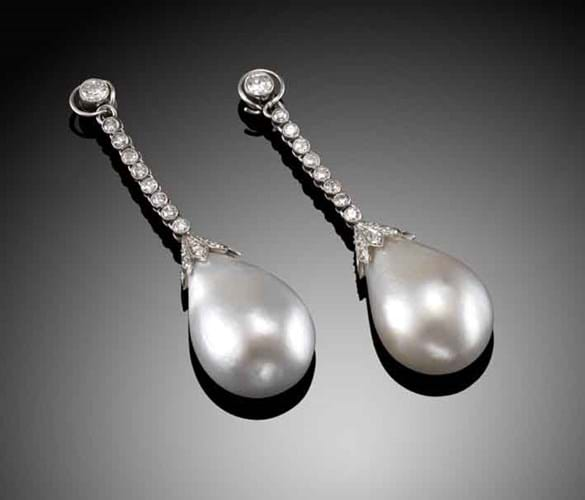
Natural (as distinct from cultured) pearls are extremely hot right now with some sources estimating they have doubled price in 12 months.
But what made the earrings sold by Woolley & Wallis for £1.4m on April 26 worthy of a sum the like of which is typically reserved for gemstones? Primarily it's all about size, shape and colour.
While in the diamond world, 10 carats is the benchmark for a major stone, the equivalent with pearls is 25cts or 100 grains (4 grains = 1ct).
Specialist Jonathan Edwards - who described the discovery of the earrings as the highlight of his 35-year career in the jewellery trade - sent them to the Swiss Gemmological Institute or SSEF (Schweizerische Stiftung für Edelstein-Forschung) for testing. The report came back glowing.
In addition to confirming that both were natural saltwater pearls weighing 34.508cts (138.03 grains) and 33.235cts (132.94 grains), it also marked them as the eighth biggest pair of pearls in the world and particularly beautiful for both their form and their colour, graded white with rose and blue overtones.
The general consensus was that they were from the Arabian Gulf, the source of so many of the most desirable natural pearls, with North West Australia another possibility.
Added to this was a European royal provenance.
Although kept loose in a drawer by the vendor for three decades, they had probably been a gift from the upstart Crown Prince Carol (later King Carol II) of Romania to his mistress, Elena 'Magda' Lupescu (c.1895-1977).
Having renounced the throne in 1926, Carol unexpectedly returned to Romania in 1930 to begin a ten-year reign marked by 25 different governments, a short-lived royal dictatorship, the loss of territories to foreign rule and abdication in 1940.
In exile he settled in Portugal, finally marrying Lupescu, who became Princess Elena von Hohenzollern, in 1947.
Elena left her pearls to a British lady upon her death and they were later inherited by her nephew and his wife who mentioned them as an afterthought during a valuation. The Wiltshire couple had been astonished to see them estimated at £80,000-120,000.
In fact with a number of major buyers registering an interest days before the April 26 sale, it became apparent that something yet more spectacular would likely transpire.
Within a minute, bidding had risen from £70,000 to £500,000 and then to £1.1m before a more sedate contest was played out on the telephones between a Swiss dealer and a private client placing bids through Jonathan Edwards.
Auctioneer Paul Viney (steadfastly refusing to take an increment of less than £100,000 until charmed by a bidder who said "please") finally brought the hammer down to Edwards' phone at £1.4m. Woolley's were not at liberty to disclose the nationality of their client but a buyer from either India or the Gulf (where traditionally pearls are most highly prized) is a good bet.
A buyer from the People's Republic is unlikely. Despite the history of perliculture in the Far East (the art of growing pearls was discovered in Japan in the early 1900s) Chinese buyers are yet to dip their oar in the deep waters of this particular market.
Back to the sale results, a taste of things to come had been provided by the previous lot from the same source - a ring comprising two cream and black natural pearls set with baguette shaped diamonds in a platinum mount. Dating from the late 1930s (the earrings were thought to be early 20th century), it was signed for Rue de la Paix jeweller Mellerio.
Estimated at £15,000-20,000, bidding had begun at £8000 but was accelerated by 'shut out' bids of £50,000, then £100,000 and finally £150,000 by the gentleman on the end of Jonathan Edwards' telephone. Clearly this was one very determined individual to go with one delighted vendor and a very happy firm of auctioneers.
The buyer's premium was 22/12%




